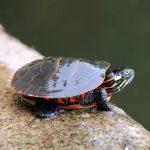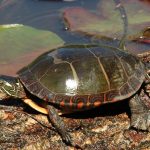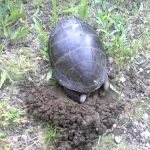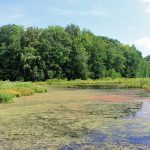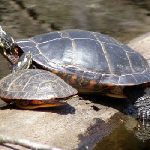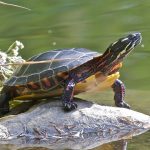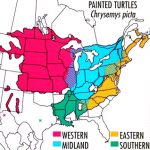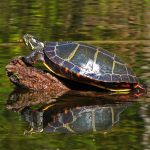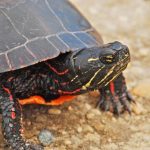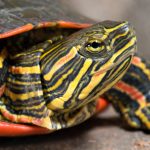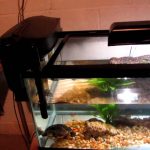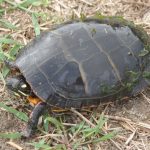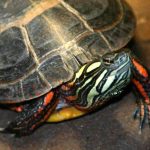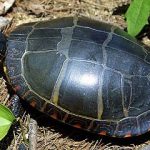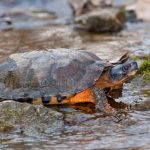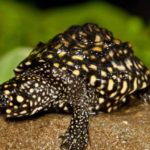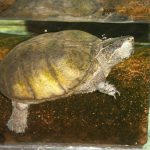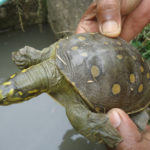Eastern Painted Turtle
Eastern painted turtles are one of the four recognized subspecies of painted turtles. They seldom move on land except during the nesting season. Aggressive behavior has been noted during basking sessions. They are omnivores.
| Kingdom | Animalia |
| Phylum | Chordata |
| Subphylum | Vertebrata |
| Class | Reptilia |
| Order | Testudines |
| Family | Emydidae |
| Subfamily | Deirochelyinae |
| Genus | Chrysemys |
| Species | Chrysemys picta |
| Scientific Name | Chrysemys picta picta |
| Size | 4.5 – 6 in; largest recorded specimen measures 7.2 in |
| Weight | Up to 600 g |
| Color | Olive to black outer shell with red or yellow borders along the seams and red bars on the margins; yellowish underside; olive to black skin with red and yellow stripes on the neck, legs and tail; an uneven yellow line on each side of the head at the back of the eyes |
| Distribution | Maine, North Carolina, South Carolina, Georgia, Virginia |
| Habitat | Permanent, beaver and farm ponds, weed-choked shallow coves of large northern lakes, slow moving rivers |
| Diet | Aquatic plants like elodea, earthworms, crickets, other insects |
| Hibernation Fact | Hibernate during winter in the accumulated water under stumps or logs or in muskrat lodges or beaver |
| Predators | Juveniles fall prey to mink, muskrats, black racers, crows, bullfrogs, larger turtles, large fish while adults are preyed upon by raccoons |
| Breeding Season | March – June |
| Mode of Reproduction | Oviparous (egg laying) |
| Clutch Size | 3 to 9 eggs |
| Reproductive Age | Male: 4 years of age Female: 5 years of age |
| Average Lifespan | More than 30 years |
| IUCN Conservation Status | Least Concern |
Eastern Painted Turtle Pictures Gallery
- Baby Eastern Painted Turtle
- Chrysemys Picta Picta
- Eastern Painted Turtle Eggs
- Eastern Painted Turtle Habitat
- Eastern Painted Turtle Images
- Eastern Painted Turtle Pictures
- Eastern Painted Turtle Range
- Eastern Painted Turtles
- Eastern Painted Turtle Photos
- Eastern Painted Turtle
- Eastern Painted Turtle Tank Setup
- Eastern Painted Tturtle Size
- Eastern Painted Turtle Care
- Eastern Painted Turtle Shell


